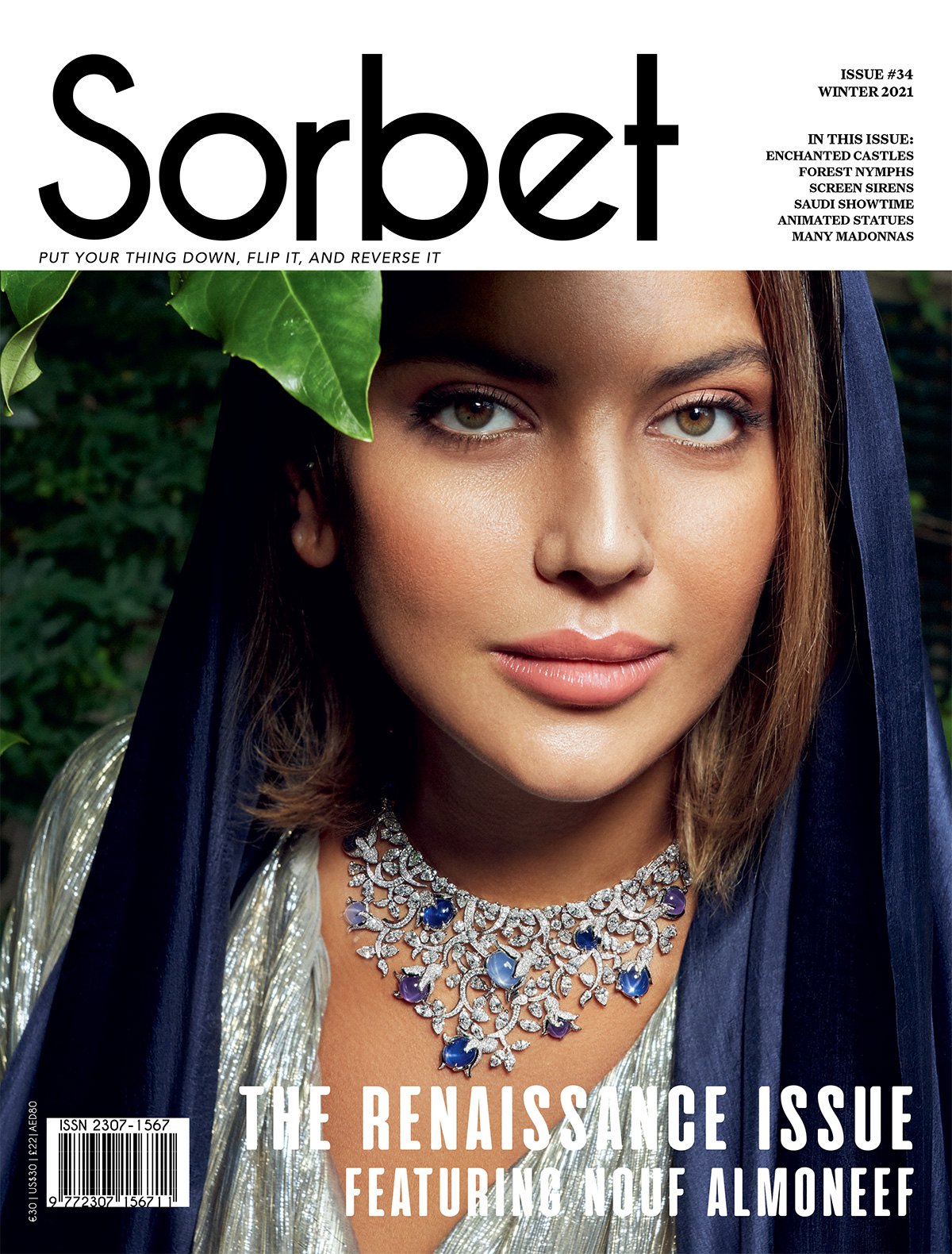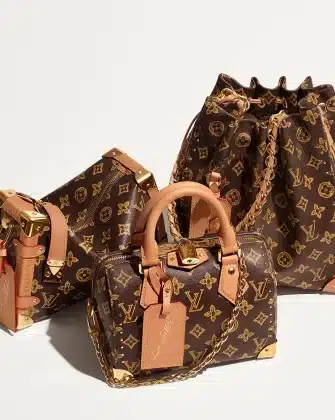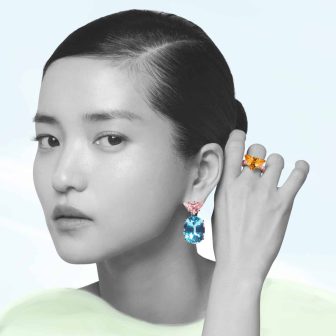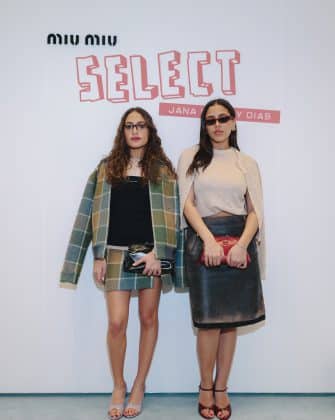THE ITALIAN JOB STARRING IKRAM ABDI
Written By: William Buckley
THE ITALIAN JOB STARRING IKRAM ABDI
New supers don’t come cooler than Ikram Abdi. A London girl with East African roots and a sharp sense of humor, she’s part of a generation tearing up the tired rules of fashion and building a fresher, freer definition of beauty in its place. One of the first hijabi models to hit international runways, Ikram’s ascent has been nothing short of meteoric – landing campaigns with major brands, striding through Fashion Weeks from Paris to New York, and rewriting industry codes with every strut.
For Sorbet’s sun-drenched Summer issue, The Italian Job, we whisked Ikram off to Rome – the spiritual home of Bvlgari – for a high octane shoot dripping in diamonds, emeralds, and just enough scandal. Between takes at the outrageously glamorous Villa Miani (think fountains, frescoes, and men carved from marble), Ikram spoke to us about her unlikely start in fashion, the challenges she’s faced, and what it means to proudly wear her hijab on global runways.
We got into the beauty myths she’s ready to leave behind, the books she never travels without, and what really makes her feel at home, whether she’s front row at couture or lost in a London bookshop. As generous as she is sharp-witted, Ikram reflects on a career built not on compromise but confidence.
WILLIAM BUCKLEY: Let’s start at the beginning: tell me how you first got into modeling?
IKRAM ABDI: Okay, let’s throw it back here. So, I was in Bristol, and I literally just applied to a bunch of agencies.
WB: In Bristol or in London?
IA: I’m from Bristol; I moved to London in 2018, but I was in Bristol at the time, a biomedical science student, so I was just online, looking at how I can get into fashion and modeling. I emailed IMG Models, Select, Next, you name it. I sent all my images.
WB: You had professional images?
IA: Yeah, taken by a random photographer I hit up in Bristol. I did the research; on all the websites, all of them required professional images to apply. You can’t just send random selfies. So I was like, cool, let me strip away all the makeup, because at the time, in Bristol it was huge lashes, dramatic looks. So I stripped that all away so they could really see what I was working with. It’s like a canvas; I took pictures, headshots, side profile, head to toe, kept the outfits really simple. And obviously I wanted to go for the bigger agencies, but I figured maybe the top two or three might not accept me. You know? Would be more of a challenge – they’re looking for someone that’s got more experience. But I searched the top 10 London agencies, applied to them all, and then the ninth or tenth got back to me. It was like a small agency called Bookings. So that’s how I started.
WB: Love Bookings.
IA: Yeah, they’re really good. I did an interview with them. I pitched the diversity thing, the inclusivity thing, and they loved it. I told them, “Look, there’re no headscarf-wearing models in Europe. There’s a huge market – the Middle East for example, number 1 – and they need faces, headscarf wearing women need to be represented. Women in headscarves are out here doing high-end things. When I was younger, I didn’t see anyone that looked like me in magazines. And that would have meant so much to me growing up – someone to look up to. And I figured I would absolutely love to do that. I’ve loved fashion for the longest. I actually wanted to apply a couple years before that, but I just knew my parents wouldn’t allow it if I was too young. So I was like, let me do my A-levels and stuff. I waited until I was 21 years old, and it still took a lot of convincing, but my parents were like, “You know what? Go for it.”
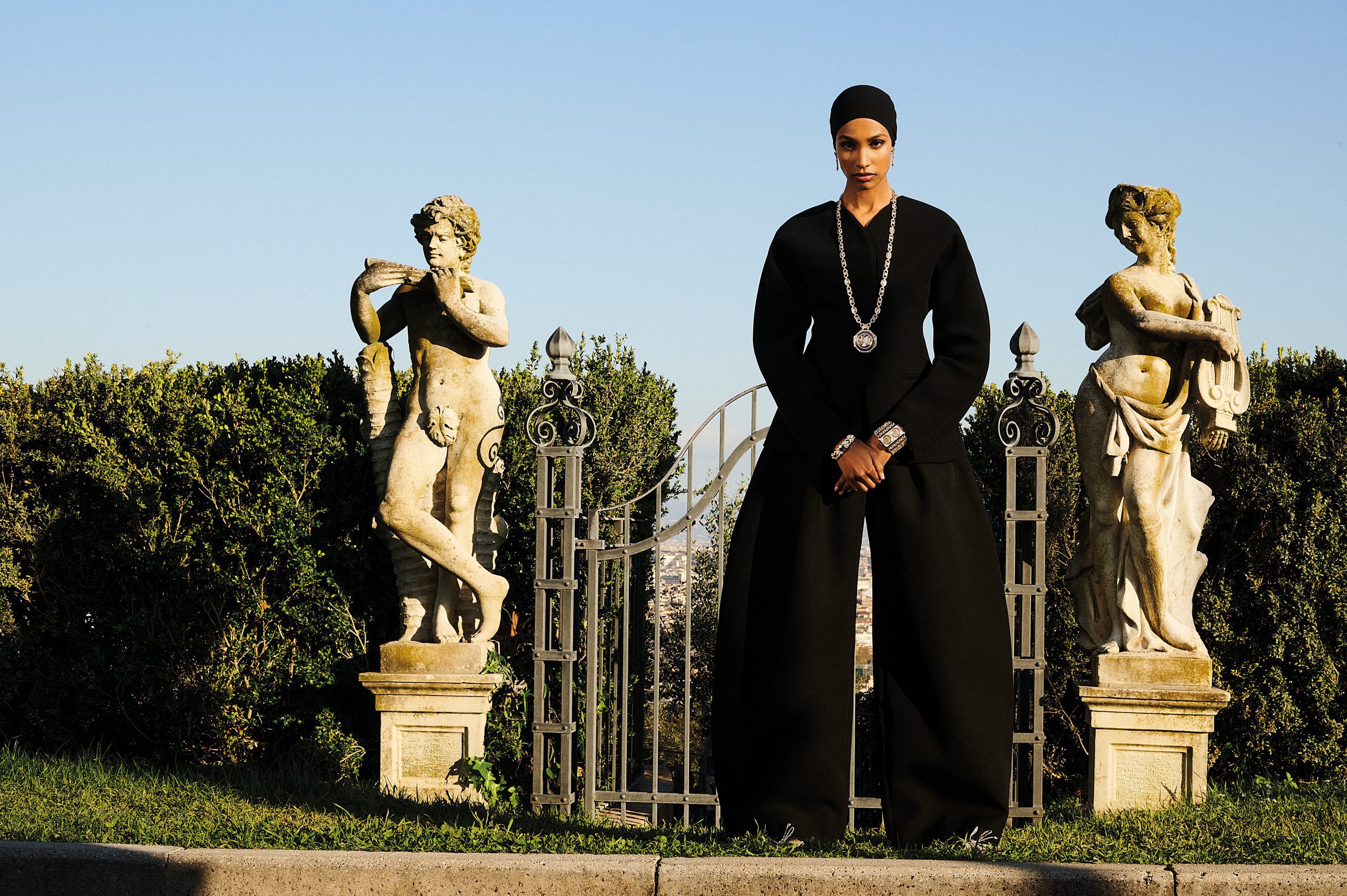
Sorbet Magazine
Earrings, Monete Cameo high jewelry necklace secret watch, Monete Catene Dual Time high jewelry secret watch, Monete Septimius Severus and one Monete Julia Domna, Bvlgari High Jewelry; jumpsuit, Jacquemus
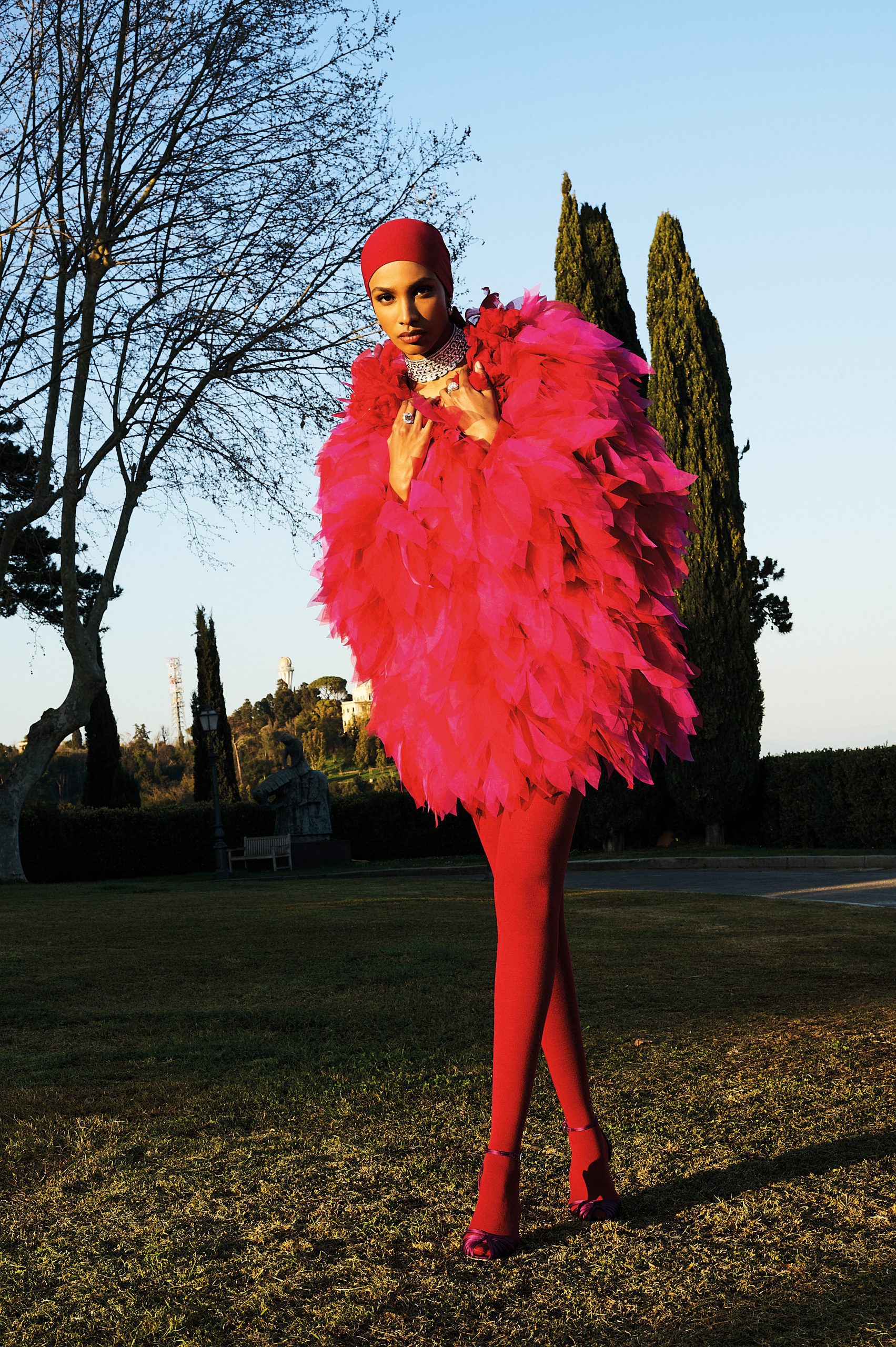
Sorbet Magazine
Earrings, necklace, and rings Bvlgari Polychroma High Jewelry; Look, Giambatista Valli
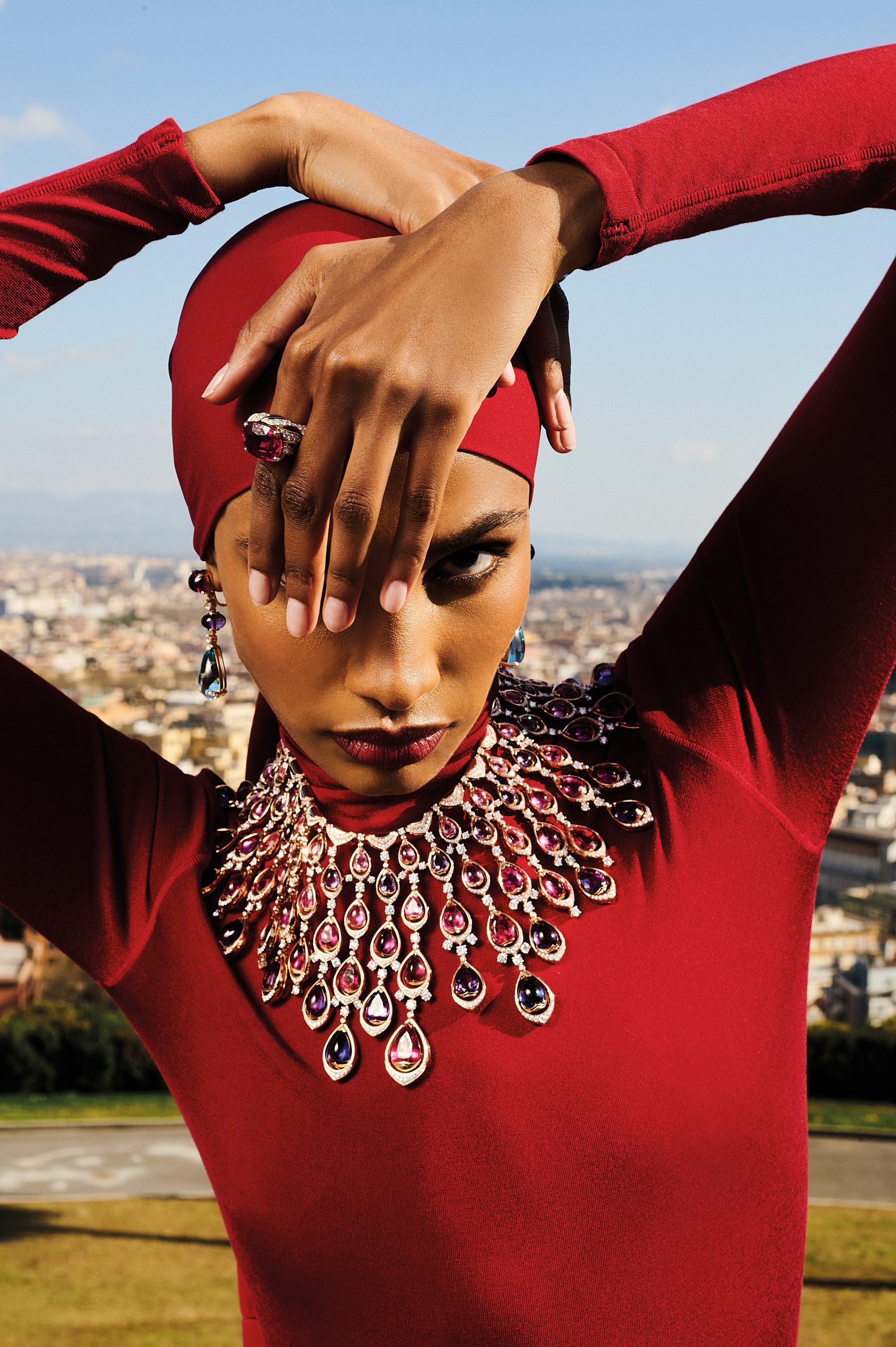
Sorbet Magazine
Ring, earrings, and necklace, Bvlgari Polychroma High Jewelry; bodysuit, Calcaterra
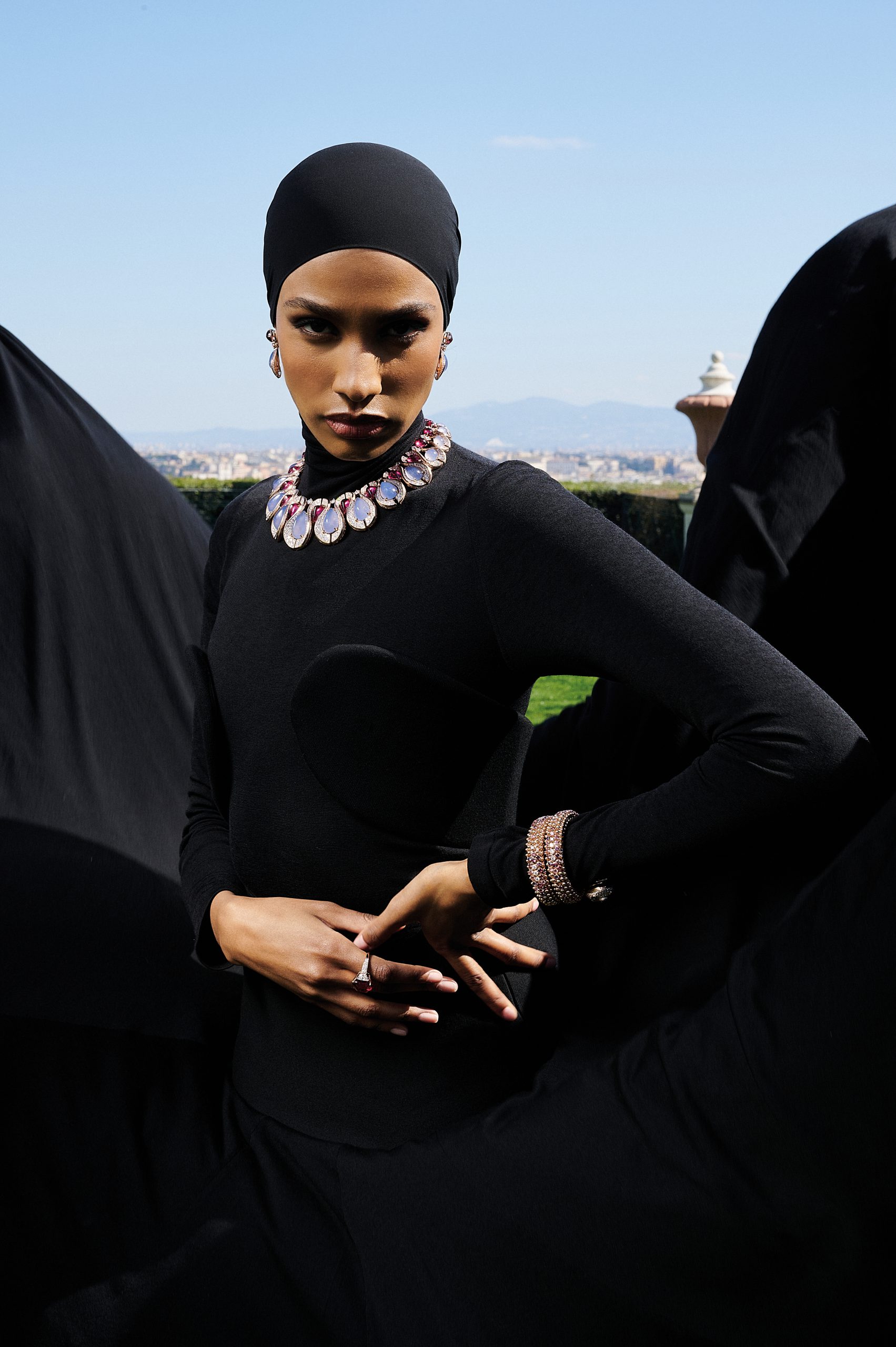
Sorbet Magazine
Earrings, necklace, ring, and Serpenti Misteriosi Pallini High-Jewelry watch, Bvlgari Polychroma High Jewelry; Dress, ALAÏA
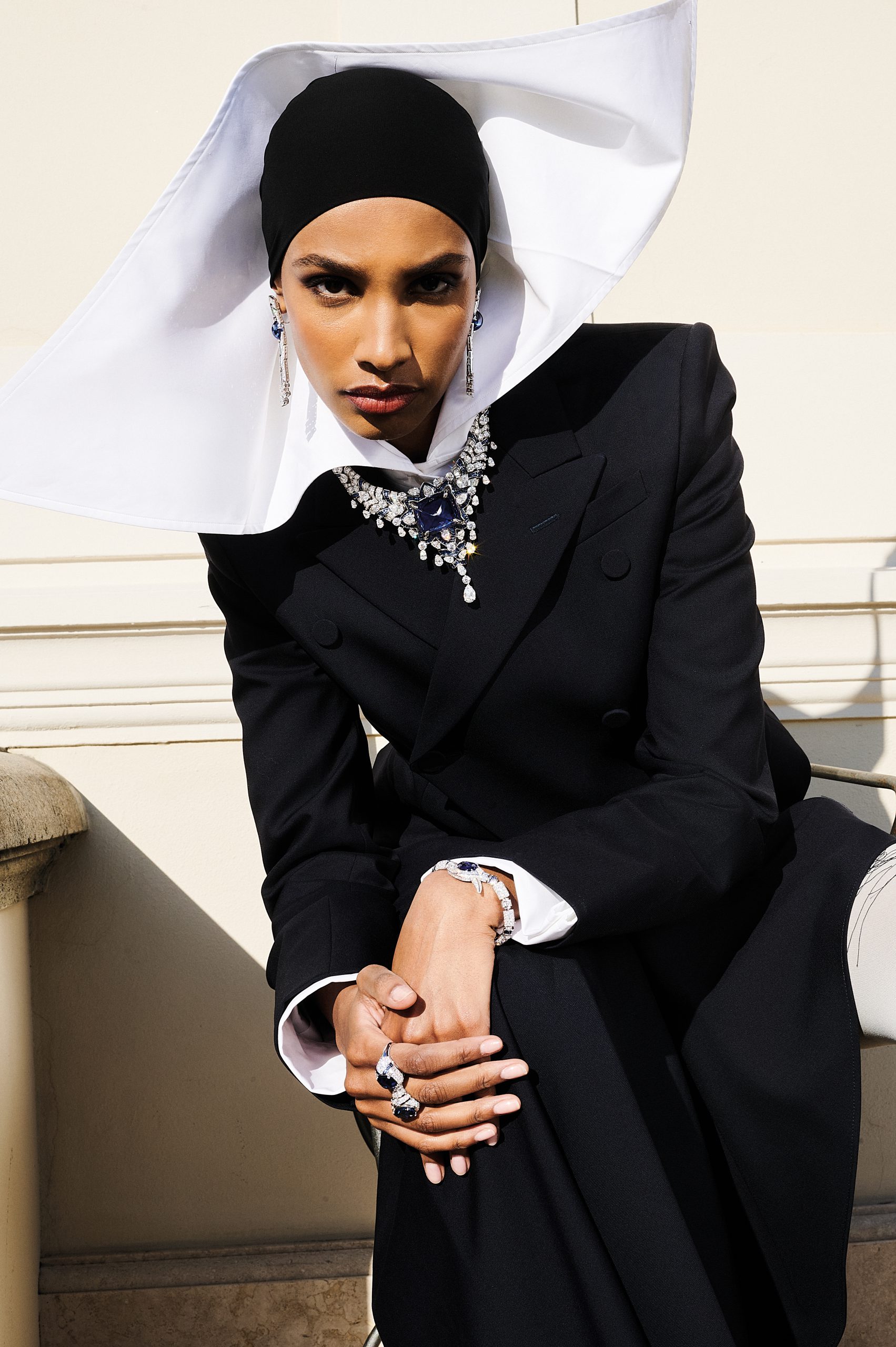
Sorbet Magazine
Earrings, necklace, Serpenti bracelet, and rings, Bvlgari Polychroma High Jewelry; Suit, Alexander McQueen
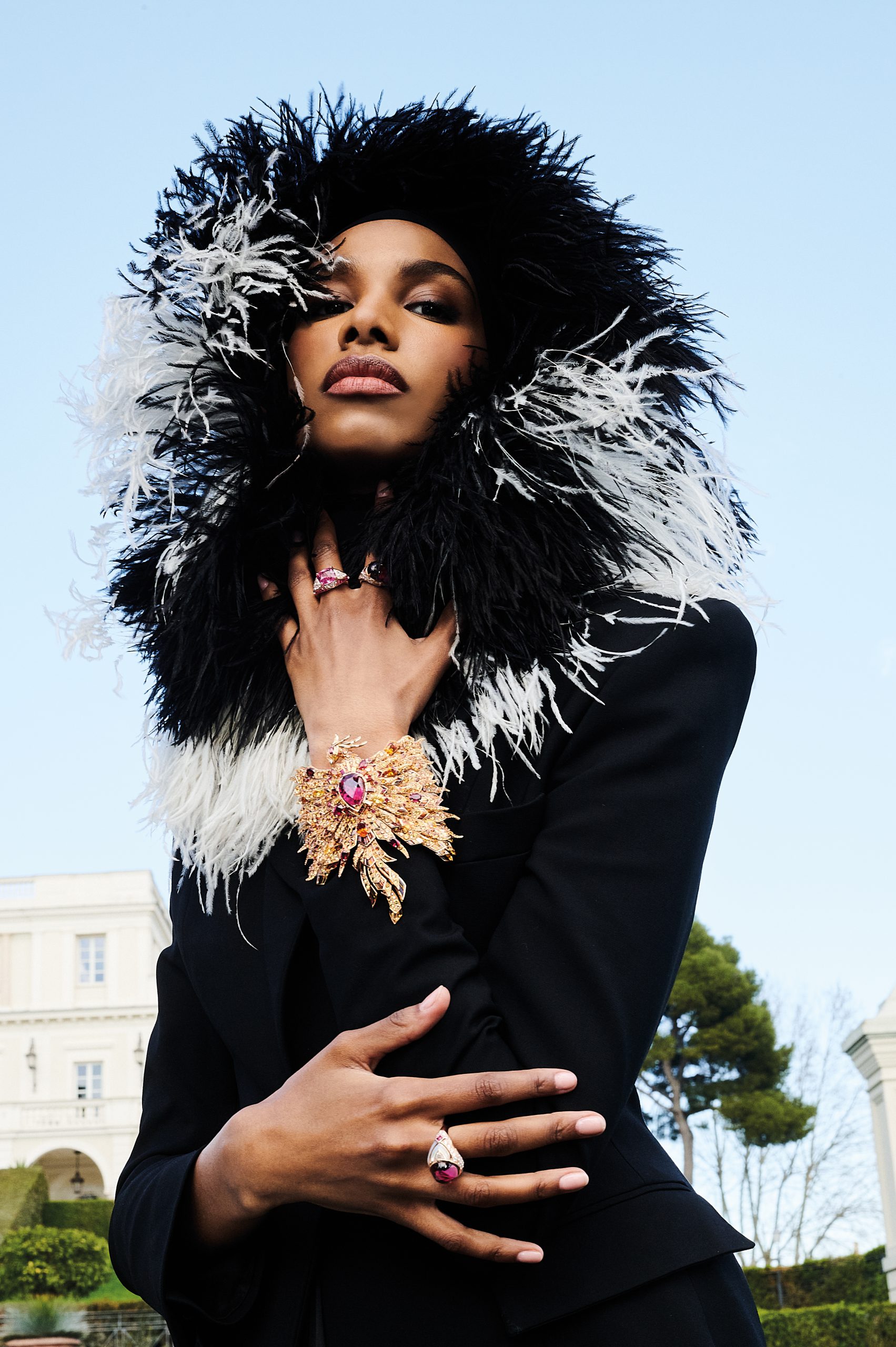
Sorbet Magazine
Rings and secret watch, Bvlgari Polychroma High Jewelry; Dress and headpiece, CHB Christian Boaro
WB: So good. And that was that? You got signed by Bookings, and you were booked and busy?
IA: Yeah, 2018, they started booking me. I started working with brands like Primark. I was doing M&S, other shoots here and there for websites, editorials for magazines, a mix. I was just starting out, so I was really excited. I remember I got a couple pages in my first magazine, and it was so cool. They had me dressed in Tom Ford, and I was like, “This is it, I’m dying, I’m gagging.”
WB: And what about runway?
IA: So, runway did start with Bookings – I was still with them – but I was about to leave for a bigger agency. I felt like I’d grown, and I had a stronger portfolio. But I did do Molly Goddard; that was my first show. Autumn/Winter 2018. Iconic as hell.
WB: So iconic. I love. Were you wearing one huge bouffant?
IA: It was a big beige dress. And then they were like, “You can style your scarf the way you want it.” I loved it. I wore my black scarf. Because at the time I was in a “black just goes with every color” space. Molly was very sweet. I remember doing the casting. I was super shy, but she was all about wanting to have diversity on her runway.
WB: And what was that experience like? Were you practicing in your living room? What was the backstage like? What was going through your head?
IA: So much was going on in my head; I actually cried backstage, because it was on my bucket list. I had a list of things I wanted to do when I got into modeling, and one of them was walking London Fashion Week, because I knew once you got in with London Fashion Week, it would open doors in other cities down the line. So, I was crying backstage, like “Oh my God, this feels like the start of something, you know?”
WB: Were you crying with your makeup done?
IA: I was crying with my makeup about to go walk. I told the makeup artist “Please, can we touch this up quickly? I’m getting bad, I’m sorry.” I kept apologizing, thinking this is something I’ve always wanted to do, and it’s happening right now, I don’t want to ruin the makeup. I was really trying to control it.
WB: Were you nervous? Or were you ready to serve the walk? How did that go?
IA: I was so nervous, but also confident. I’ve always loved taking pictures, but a walk is completely different. I always used to do this walk in my house, in Bristol, in front of my family, like “Guys, I’m about to be doing runway one day.” I’d put on heels and I’m giving everyone a show. This was a different story – it’s not your family. But the minute I stepped out, I don’t know, I gained this kind of confidence. I was just trying to strut that runway, but also in a modest way; I wasn’t trying to do too much. And we practiced during the rehearsals, right? So, I gauged the vibe, you know, can’t do too much here,it has to be composed, not too many facial expressions. We were guided before the actual show. So, I just made sure I took note of everything. Shout out to rehearsals. If there wasn’t a rehearsal, I don’t know.
WB: Yeah, exactly. You feel a bit more like you’ve got this, like, you know what they want.
IA: I asked all the questions backstage, and I did practice the walk. Thankfully the heels weren’t too crazy. It was a decent sized heel still. I was so dedicated when I was in Bristol, because I knew down the line, I would potentially do runway shows if I really stuck to it. So, I used to clean the house in heels.
WB: Oh, nice. That’s good training.
IA: Yeah. People sometimes practice on treadmill, but I just got comfortable walking in heels and doing loads of things, picking up bags, heavy stuff in heels. Just so it felt much lighter when you’re on the runway, because you’re not really carrying anything.
WB: That’s kind of genius.
IA: Yeah, cleaning! You’re moving this, wiping this, picking up this. And, oh my gosh, the way my mom keeps reminding me every time I’ve got a major show… “Cleaning in the heels…”
WB: Do you think the headscarf helped you get your start?
IA: It helped because I was looking ahead. I know modest fashion, and I know a lot of people spend a lot, so these brands are gonna realize they need people to represent that. You can see now, designers are making collections specifically for the Middle East. I figured I need to get in now; it’s a niche now, but it’s growing; it has to. I did two years of uni, and it was supposed to be three years, but I took a gap year; I felt the momentum was picking up, I thought, this has to be now. The head scarf is part of who I am, but it’s also a strong focal point. This is who I am, and brands should be able to work with me for who I am, regardless. My headscarf shouldn’t limit me to be able to do anything I want.
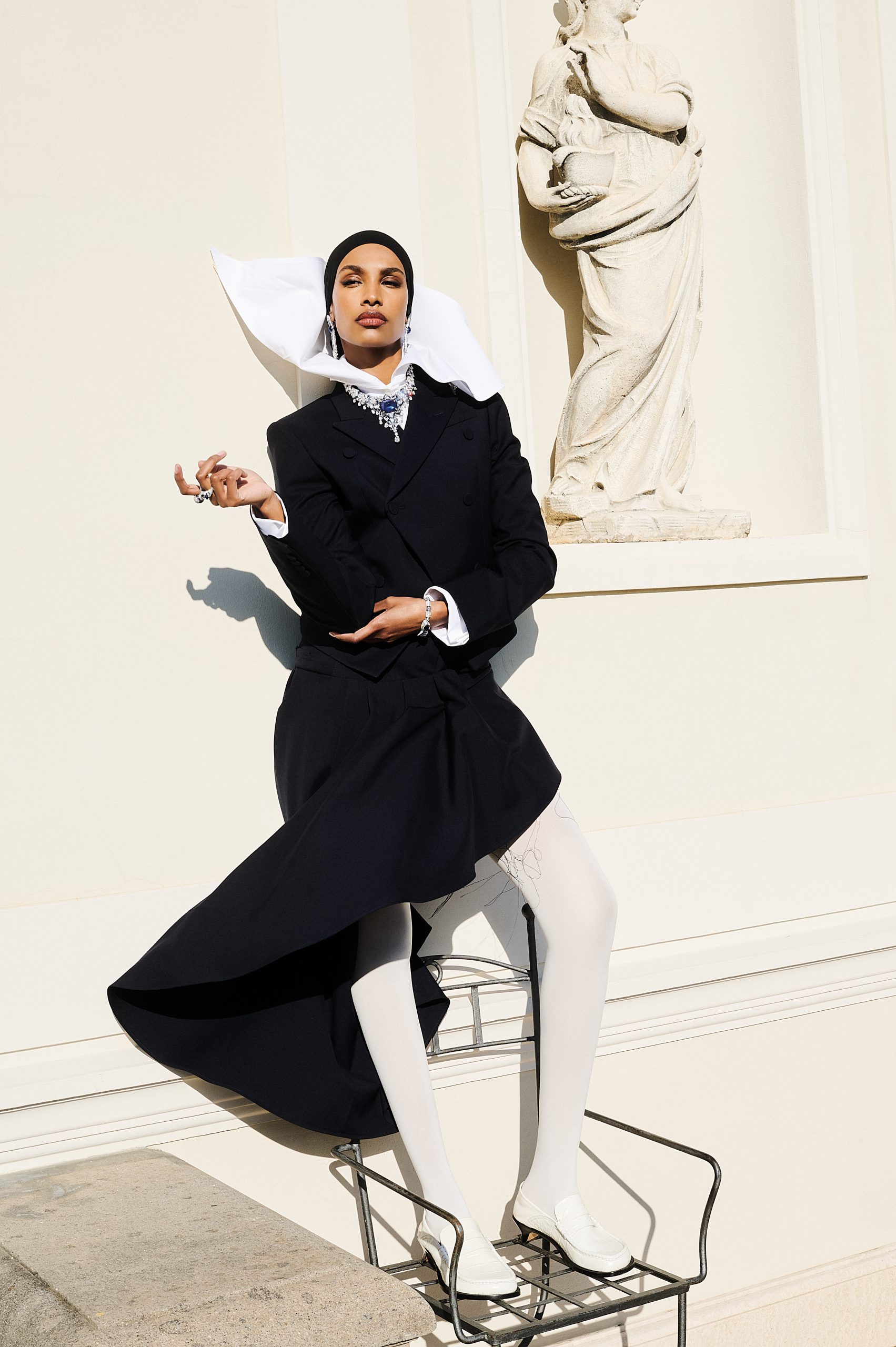
Sorbet Magazine
Earrings, necklace, Serpenti bracelet, and rings, Bvlgari Polychroma High Jewelry; Suit, Alexander McQueen
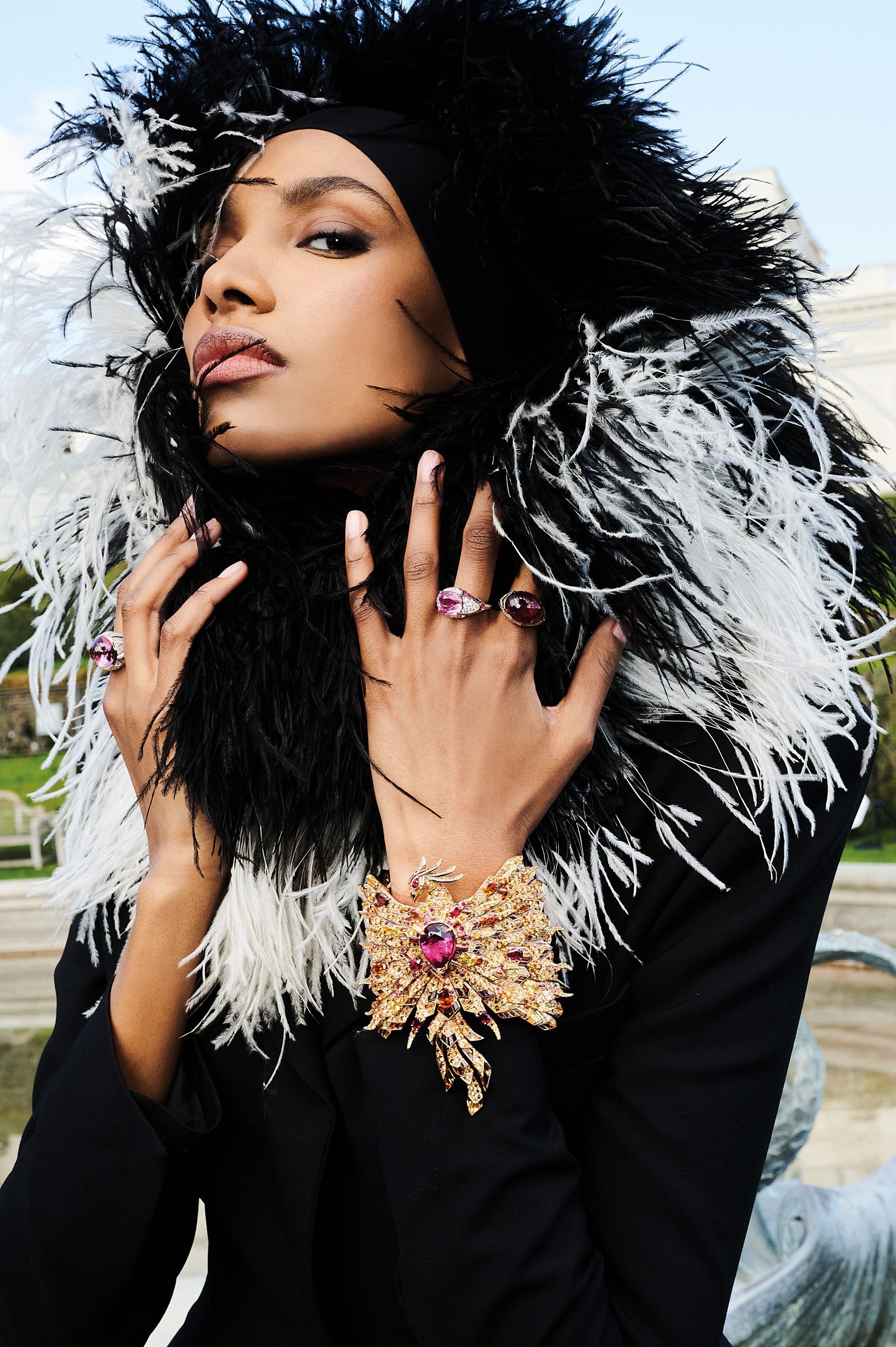
Sorbet Magazine
Rings and secret watch, Bvlgari Polychroma High Jewelry; Dress and headpiece, CHB Christian Boaro
WB: How have you found the response?
IA: I’m out here trying to change the narrative. I want to show people that wearing the headscarf and fashion go hand in hand. Even if you don’t see it as a religious or cultural statement, and take that out, it’s another piece of fabric that you can work with and have fun and play with. At interviews and castings, it was basically me pitching myself to the brands and telling them to be more open-minded. When I started doing jobs and stuff, the first people that first supported me were people from my country, and people that wore the headscarf from different countries – they felt representation, and that gave me a push.
WB: Your parents are from Somalia, you were actually born in Sweden, right? Then Bristol, and now London. How do all those influences manifest?
IA: Yeah, I was a Scandi girl up until eight years old, which is great, because I genuinely feel like in Sweden, they really do prioritize the quality of life for children. I felt like my childhood was incredible. Bristol was great, and now I’ve been in London close to 10 years.
WB: Do you feel like a Londoner now? You have a Londoner energy.
IA: I think because I was constantly putting myself out there, and I was outside, I was networking, I was going to events, I was walking road, so I felt like I really got the vibe of London. I was bouncing around, going to castings, being sent to locations, doing test shoots in people’s homes. Then you get introduced to the event space as well. Once you start modeling and booking decent jobs, they’re like, oh, you should attend this event that’s happening here and here. And that’s how I really got familiar with London, really, was that just being constantly outside and exploring and touring.
WB: How do you feel your Somali heritage has shaped you as a person?
IA: I feel like just coming from a Somali household to begin with, you get taught to be really confident. The Somali mindset is very ‘don’t let anybody tell you that you can’t do something.’ And that’s the mindset I had, even going into school. You get taught to really make sure that you stand up for yourself and speak up for yourself. And that’s another thing that helped me speak to a lot of these brands, at castings; I had that confidence to just be like, hear me out. You know?
WB: Is that cultural?
IA: It’s very cultural. We’ve got a lot of strength and pride in Somali culture. and we’re very confident out there. I feel like it’s instilled in us from young,
WB: And then, what about London?
IA: London has given me that confidence to put myself in the rooms.
WB: Are there things in the modelling space that you still want to do? What do you see in the future?
IA: So, I feel like it’s changed over the years, because the industry has become more diverse, but in a sense, you feel like there’s still a long way to go.
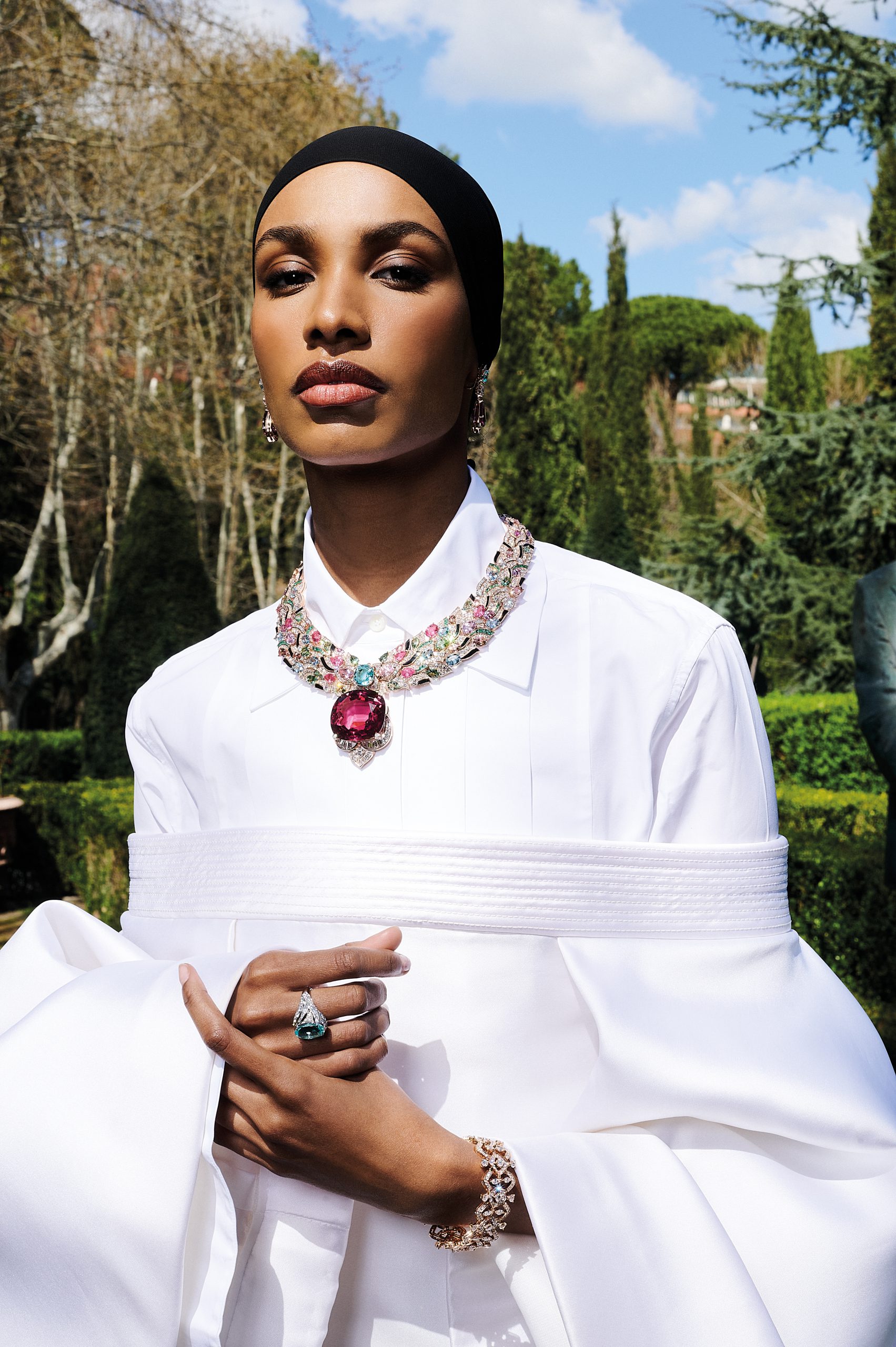
Sorbet Magazine
Earrings, necklace, ring, and bracelet, Bvlgari Polychroma High Jewelry; Dress and shirt, Sylvio Giardina
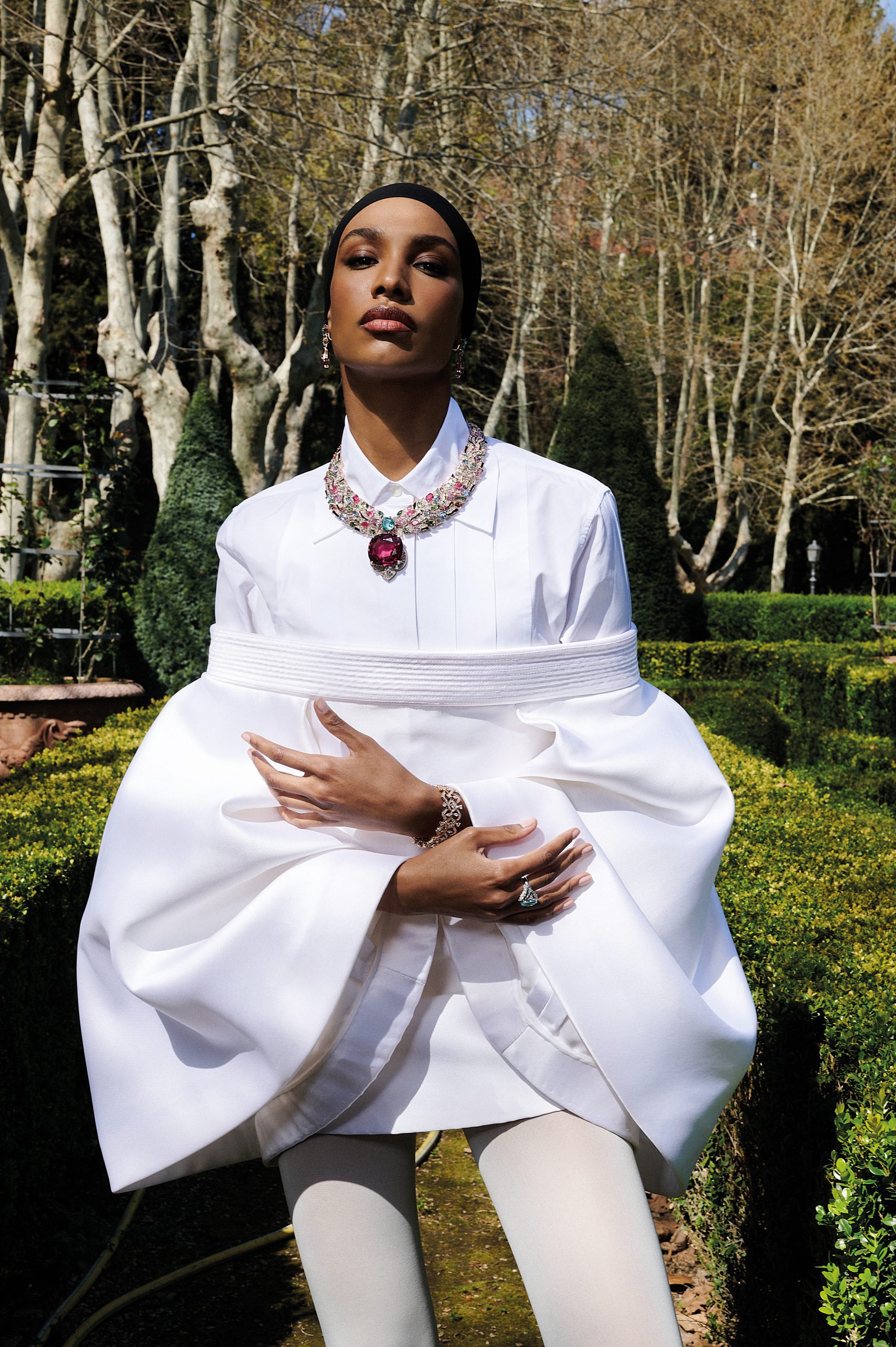
Sorbet Magazine
WB: Yeah, one minute this runway is super inclusive; the next year, it will be like, we seem to have regressed…
IA: For sure, and you don’t want it to be tokenism, like, ‘Okay, we’ve got our headscarf wearing model, check.” It shouldn’t be a trend; it should be the same as booking any other model, and it’s not there yet.
WB: Are there any designers that you still haven’t worked with, that you really want to work with?
IA: Tom Ford would be insane. Or a campaign for Tom Ford; that’s a brand I’ve always loved. I would love to do the eyewear campaign; I’d be so excited.
WB: I love those campaigns.
IA: They’re so chic and classic, and even Tom Ford himself. Just look at him, wow. I’ve worked with the Tom Ford Beauty team, but I don’t know the fashion team, so I guess maybe one day, just gotta see if the stars align, if it’s meant for me…
WB: What’s one misconception people have about modeling that is not the case?
IA: Oh, I feel like a lot of people think it’s so easy. They don’t know the grind, the long hours, late nights, running around town, not booking jobs. It’s not easy.
WB: I know it’s a grind.
IA: And you gotta go through it. I remember doing shows when my heels are too tight, but you just got to thug it out. Like, yes, I’m getting blisters, but I’m like, beauty hurts.
WB: So, we’ve manifested Tom Ford, potentially an eyewear campaign and/or runway. What else are we manifesting?
IA: We’re manifesting me having my own brand.
WB: A modest brand?
IA: It’s a bit hush hush, but I’ll give you the exclusive, because I love you. I’m starting a scarf brand; it’s been in the works, and it’s not just because its modesty. These scarves are for everyone, for the party girls in Ibiza that want to put a scarf on the hat and turn up to Keinemusik, the scarf is for people that want to put it on their head, on their waist, around their neck – however they want to style it. It’s not a religious statement; it’s a scarf for everyone. The designs that I’ve been working on are heavily inspired by Somalia, the architecture, the landscapes, the culture. Did you know Somalia has the longest coastline in Africa? 3,300 kilometers along the Gulf of Aden and the Indian Ocean. Shoutout to all Africa. So that’s the story.
WB: That’s so exciting. When are we launching?
IA: It’s been in the works for three years. I’m a perfectionist, but it’ll be out soon.
WB: I can’t wait. Let me know and we’ll feature it. Finally, last question, what’s your favorite flavor of sorbet?
IA: I love this question. Either mango or raspberry
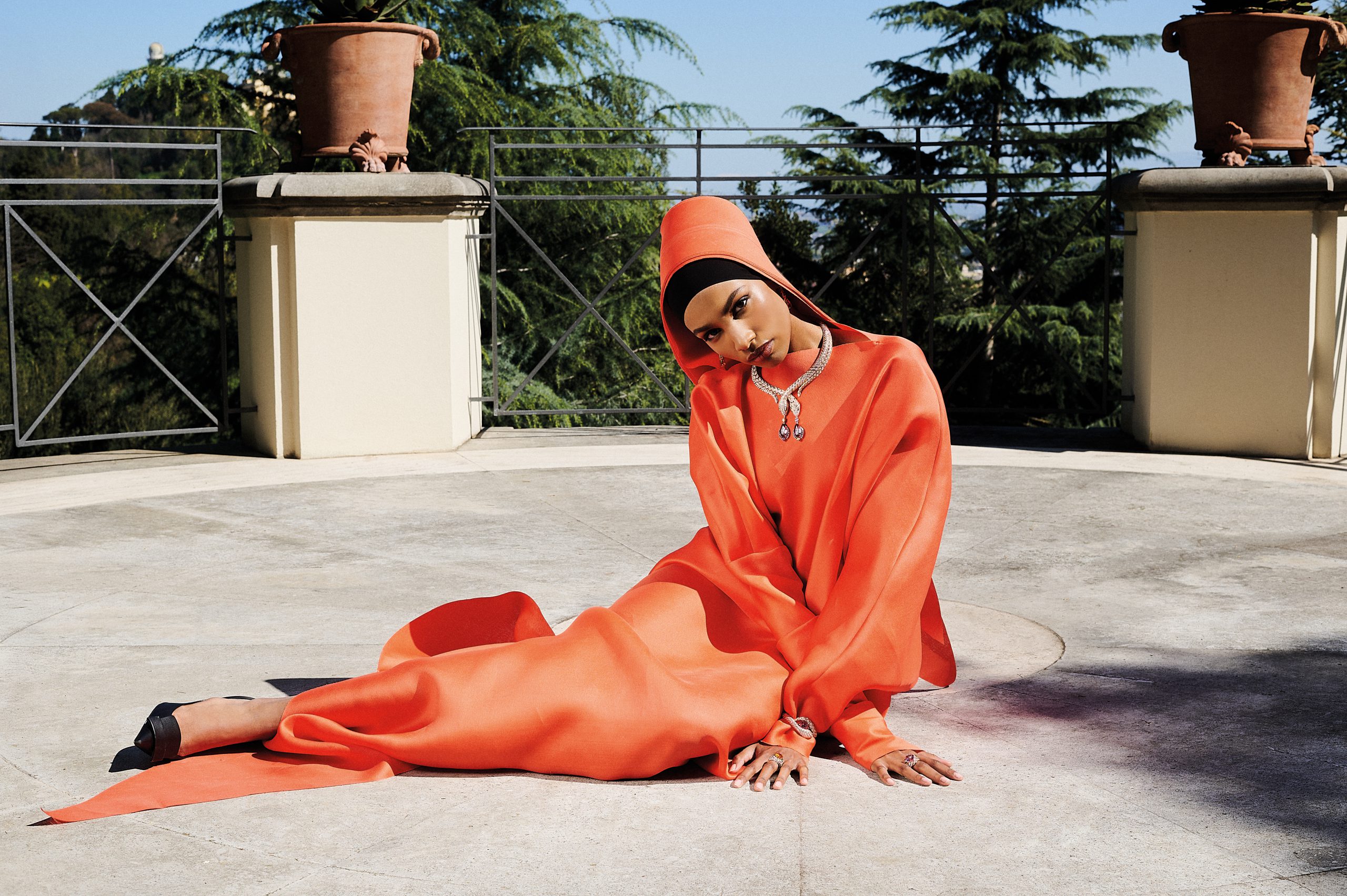
Sorbet Magazine
Earrings, Serpenti necklace and bracelet, rings Bvlgari Polychroma High Jewelry; Dress, custom Aurelio Biocchi Couture
Creative Concept Studio Sorbet | Photographer Antonio Dicoratio | Videographer Alex Bolcsak | Editor William Buckley | Production Jean-Marc Mondelet | Stylist Veronica Bergamini | Makeup Daniela Isabella | Fashion Assistants Taira Ceci, Lorenzo Muscara | Lighting Assistant Ciro Meggiolaro Talent Ikram Abdi| Jewelry Bvlgari Polychroma High Jewelry Collection| Location Villa Miani | City Rome

